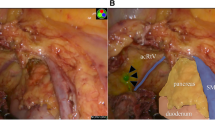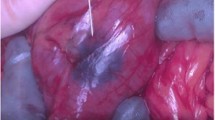Abstract
Purpose
Although numerous studies have highlighted the potential value of indocyanine green (ICG) imaging in lymph node dissection of cancer surgery, its efficacy and optimal method remain to be clarified. This study aimed to investigate how lymphatic flow observation via ICG fluorescence could contribute to colon cancer surgery.
Methods
From October 2018 to March 2021, a total of 56 patients with colon cancer who underwent laparoscopic complete mesocolic excision with intraoperative ICG imaging were analyzed. Lymphatic flow was examined at the following time points following ICG injection: within 5 min, 30–60 min, and over 60 min. We also evaluated the distribution of ICG fluorescence per each vascular pedicle.
Results
Lymphatic flow was observed within 5 min following ICG injection in 6 cases (10.7%), and at 30–60 min following ICG injection in 43 cases (76.8%). ICG-stained vascular pedicles were variable especially in hepatic flexural, transverse, and splenic flexural colon cancer. Lymph node metastases were observed in 14 cases. Although metastatic lymph nodes were present only in the area along the ICG-stained vascular pedicles in 12 of the 14 cases, two patients exhibited lymph node metastasis in areas along the ICG-unstained vascular pedicles. ICG fluorescence was observed outside the standard range of lymph node dissection in 9 cases (20.9%: 9/43). Although addition of the proposed resection areas was made in 8 of these 9 cases, there was no pathologically positive lymph node.
Conclusion
Real-time ICG fluorescence imaging of lymph nodes may improve the performance of laparoscopic colon cancer surgery, although its oncological benefit is not yet clear.




Similar content being viewed by others
Data availability
The datasets used and/or analyzed during the current study are available from the corresponding author on reasonable request.
Change history
16 February 2023
A Correction to this paper has been published: https://doi.org/10.1007/s00423-023-02824-5
References
Heald RJ (1988) The 'Holy Plane' of rectal surgery. J R Soc 81:503–508
Hohenberger W, Weber K, Matzel K, Papadopoulos T, Merkel S (2009) Standardized surgery for colonic cancer: complete mesocolic excision and central ligation--technical notes and outcome. Colorectal Dis 11:354–364
West NP, Hohenberger W, Weber K, Perrakis A, Finan PJ, Quirke P (2010) Complete mesocolic excision with central vascular ligation produces an oncologically superior specimen compared with standard surgery for carcinoma of the colon. J Clin Oncol 28:272–278
Rusu MC, Vlad M, Voinea LM, Curcă GC, Sişu AM (2022) Detailed anatomy of a left accessory aberrant colic artery. Surg Radiol Anat 30:595–599
Murono K et al (2022) Vascular anatomy of the splenic flexure: a review of the literature. Surg Today 52:727–735
Gamo E et al (2016) The superior mesenteric artery and the variations of the colic patterns. A new anatomical and radiological classification of the colic arteries. Surg Radiol Anat 38:519–527
Hirche C et al (2012) Ultrastaging of colon cancer by sentinel node biopsy using fluorescence navigation with indocyanine green. Int J Colorectal Dis 27:319–324
Currie AC et al (2017) A pilot study to assess near infrared laparoscopy with indocyanine green (ICG) for intraoperative sentinel lymph node map** in early colon cancer. Eur J Surg Oncol 43:2044–2051
Villegas-Tovar E et al (2020) Performance of Indocyanine green for sentinel lymph node map** and lymph node metastasis in colorectal cancer: a diagnostic test accuracy meta-analysis. Surg Endosc 34:1035–1047
Liberale G et al (2018) Indocyanine green fluorescence imaging for sentinel lymph node detection in colorectal cancer: a systematic review. Eur J Surg Oncol 44:1301–1306
Watanabe J, Ota M, Suwa Y, Ishibe A, Masui H, Nagahori K (2017) Evaluation of lymph flow patterns in splenic flexural colon cancers using laparoscopic real-time indocyanine green fluorescence imaging. Int J Colorectal Dis 32:201–207
Nishigori N et al (2016) Visualization of lymph/blood flow in laparoscopic colorectal cancer surgery by ICG fluorescence imaging (Lap-IGFI). Ann Surg Oncol 23(Suppl 2):S266–S274
Watanabe T et al (2018) Japanese Society for Cancer of the Colon and Rectum (JSCCR) guidelines 2016 for the treatment of colorectal cancer. Int J Clin Oncol 23:1–34
Hashiguchi Y et al (2020) Japanese Society for Cancer of the Colon and Rectum (JSCCR) guidelines 2019 for the treatment of colorectal cancer. Int J Clin Oncol 25:1–42
Brierley JD, Gospodarowicz MK, Wittekind C (eds) (2016) TNM classification of malignant tumours, 8th edn. Wiley-Blackwell, NJ
Murawa D, Hirche C, Dresel S, Hünerbein M (2009) Sentinel lymph node biopsy in breast cancer guided by indocyanine green fluorescence. Br J Surg 96:1289–1294
Reuthebuch O et al (2004) Novadaq SPY: intraoperative quality assessment in off-pump coronary artery bypass grafting. Chest 125:418–424
Cheung TT et al (2018) Pure laparoscopic hepatectomy with augmented reality-assisted indocyanine green fluorescence versus open hepatectomy for hepatocellular carcinoma with liver cirrhosis: a propensity analysis at a single center. Asian J Endosc Surg 11:104–111
Ishizawa T, Bandai Y, Ijichi M, Kaneko J, Hasegawa K, Kokudo N (2010) Fluorescent cholangiography illuminating the biliary tree during laparoscopic cholecystectomy. Br J Surg 97:1369–1377
Pruimboom T, Schols RM, Van Kuijk SM, Van der Hulst RR, Qiu SS (2020) Indocyanine green angiography for preventing postoperative mastectomy skin flap necrosis in immediate breast reconstruction. Cochrane Database Syst Rev 4:Cd013280
Emile SH, Khan SM, Wexner SD (2022) Impact of change in the surgical plan based on indocyanine green fluorescence angiography on the rates of colorectal anastomotic leak: a systematic review and meta-analysis. Surg Endosc 36:2245–2257
Wada T et al (2019) The effects of intraoperative ICG fluorescence angiography in laparoscopic low anterior resection: a propensity score-matched study. Int J Clin Oncol 24:394–402
Kawada K et al (2017) Evaluation of intestinal perfusion by ICG fluorescence imaging in laparoscopic colorectal surgery with DST anastomosis. Surg Endosc 31:1061–1069
Wada T et al (2017) ICG fluorescence imaging for quantitative evaluation of colonic perfusion in laparoscopic colorectal surgery. Surg Endosc 31:4184–4193
Ushijima H et al (2020) Visualization of lymphatic flow in laparoscopic colon cancer surgery using indocyanine green fluorescence imaging. Sci Rep 10:14274
Ahn HM et al (2021) Optimal ICG dosage of preoperative colonoscopic tattooing for fluorescence-guided laparoscopic colorectal surgery. Surg Endosc 36:1152–1163
Kakizoe M et al (2021) The histopathological evaluation based on the indocyanine green fluorescence imaging of regional lymph node metastasis of splenic flexural colon cancer by near-infrared observation. Int J Colorectal Dis 36:717–723
Sato Y et al (2021) Snapshots of lymphatic pathways in colorectal cancer surgery using near-infrared fluorescence, in vivo and ex vivo. Eur J Surg Oncol 47:3130–3136
Watanabe J, Ota M, Suwa Y, Ishibe A, Masui H, Nagahori K (2016) Real-time indocyanine green fluorescence imaging-guided complete mesocolic excision in laparoscopic flexural colon cancer surgery. Dis Colon Rectum 59:701–705
Petz W, Bertani E, Borin S, Fiori G, Ribero D, Spinoglio G (2021) Fluorescence-guided D3 lymphadenectomy in robotic right colectomy with complete mesocolic excision. Int J Med Robot 17:e2217
Ye K, Lin J, Sun Y, Wu Y, Xu J, He S (2018) Variation and treatment of vessels in laparoscopic right hemicolectomy. Surg Endosc 32:1583–1584
Wang X, Huang S, Lu X, Huang Y, Chi P (2021) Incidence of and risk factors for gastroepiploic lymph node involvement in patients with cancer of the transverse colon including the hepatic flexure. World J Surg 45:1514–1525
Zoulamoglou M et al (2017) Anomalous origin of the right colic artery from the right gastroepiploic artery during complete mesocolic excision: a rare case report. J Surg Case Rep 2017:rjx204
Acknowledgements
The authors thank medical staffs and residents of Kyoto University Hospital gastrointestinal surgery for their participation in this study.
Author information
Authors and Affiliations
Contributions
K.K. and H.K. designed the study; contributed substantially to data acquisition, analysis, and interpretation; wrote the manuscript; and prepared the figures and tables. K.K., H.K., Y.I., R.O., N.O., T.O., and K.H. contributed to acquisition of the data. Y.I., R.O., N.O., T.O., K.H., and K.O. participated in drafting of the article. All authors revised the text critically for important intellectual content and gave approval of the final version of manuscript.
Corresponding author
Ethics declarations
Ethics approval
The study protocol was approved by the Ethics Committee of Kyoto University (Y0001), and conformed to the Declaration of Helsinki.
Consent to participate
Written informed consent was obtained from all of the study participants.
Conflict of interest
The authors declare no competing interests.
Additional information
Publisher’s note
Springer Nature remains neutral with regard to jurisdictional claims in published maps and institutional affiliations.
Supplementary informations
Rights and permissions
Springer Nature or its licensor (e.g. a society or other partner) holds exclusive rights to this article under a publishing agreement with the author(s) or other rightsholder(s); author self-archiving of the accepted manuscript version of this article is solely governed by the terms of such publishing agreement and applicable law.
About this article
Cite this article
Kinoshita, H., Kawada, K., Itatani, Y. et al. Timing of real-time indocyanine green fluorescence visualization for lymph node dissection during laparoscopic colon cancer surgery. Langenbecks Arch Surg 408, 38 (2023). https://doi.org/10.1007/s00423-023-02808-5
Received:
Accepted:
Published:
DOI: https://doi.org/10.1007/s00423-023-02808-5




